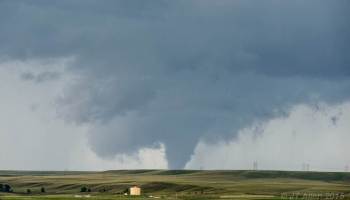With the seas warmer of a degree we will have tornados in the Mediterranean

Driven by climate chaos, hurricanes are growing and knocking on Europe’s doors. Ophelia, who in the coming days will arrive on the stretch between the north of Spain and Ireland, shows that the old continent is no longer sheltered. The Iberian Peninsula would seem to offer a sufficient shield, but a study by the CNR shows that the Mediterranean has a front-row seat on the climate risk stage.
The joint research Isac-Cnr and Iia-Cnr published in Scientific Reports shows that if the climate change already in place had not produced a temperature increase of almost a degree, the tornado that in 2012 hit Taranto causing one death and 60 million euros in damages would not have occurred. While with a degree more than the sea compared to today, in a temperate global warming scenario, the tornado would acquire much greater dimensions and violence. Then, if the thermometer rises again, that is, if greenhouse gas emissions are not reduced drastically and quickly, the intensity of destructive winds will grow exponentially.
“We applied a high-resolution meteorological model that was able to correctly reproduce all the elements that led to the birth of the tornado: the path of the storm cell, the timing, the variation in intensity”, explains Mario Marcello Miglietta, researcher Isac-Cnr and first author of the article. “And we did run the model by first simulating a situation in which the sea had one degree less than today and then a situation in which the sea had an extra degree. The results of the analysis are valid for the whole area of the Mediterranean”.
Sea temperature is the key parameter because this is where the engine that gives strength to hurricanes is hiding. “The hurricanes that hit the Atlantic coast of the United States are tropical storms that have gained strength on the Caribbean Sea: these are phenomena that can reach a diameter of a thousand kilometers with winds reaching 250 kilometers per hour, very similar to the typhoons that hit India “, explains Antonello Pasini , the other author of the article. “In Italy there are whirlwinds with a diameter of a few tens of meters which, however, having a concentrated vortex, can produce substantial damage. Now, with an increasingly warm sea, there is the real possibility that they reach much higher size and intensity “.
Since the 1980s, the so-called Medicaines have also been studied in the Mediterranean, cyclones that reach a diameter of a few hundred kilometers and could become increasingly aggressive. To reduce the risk of hurricanes, greenhouse gases must be cut, which are responsible for climate destabilization. And from this point of view, there are some positive signs: 2016 was the third consecutive year of stable global CO 2 emissions, despite global GDP growth of over 3%. Merit above all of the two largest polluters in the world, the United States and China, who are moving ahead faster than expected towards green energy.


